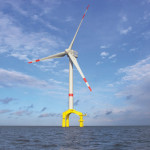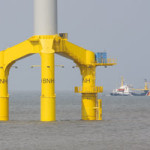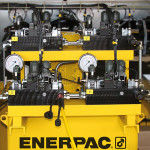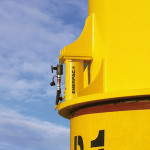Perpendicular at Open Sea

Wind turbine manufacturer Bard Engineering GmbH has developed a unique concept for the foundations of wind turbines. The mast is placed on a supporting cross piece that rests above the water surface on three main pilings. Enerpac’s Synchronous Lifting System is used to level this supporting cross piece accurately and in just a short time frame. BARD Engineering was founded in 2003 with the aim of constructing wind turbines and offshore wind farms. Based on the philosophy that they did not want to depend on a wide range of suppliers, all parts plus everything needed for the installation are developed, manufactured or assembled in their own factory. This also applies to the ‘Wind Lift I’, the ship that was specially built for installing the wind turbine farm at open sea. The ‘BARD Offshore 1’ wind turbine farm is currently under construction in the North Sea, about 100km north-west of the German island of Borkum. This wind turbine farm consists of 80 wind turbines of the ‘BARD VM’ type, 5MW machines that will be equipped with what is known as a ‘doubly-fed induction generator’ (DFIG).
Unique Foundation Concept
The Bremen-based company developed a patented concept for the foundation of the wind turbines: the BARD Tripile. The 90m high wind turbine rests on three main pilings that are each 90m in length. Depending on the ground quality, these piles are driven 30 to 45m into the sea bed using a guide frame. Their position is accurately determined using a satellite controlled navigation system. The height of these pilings above the water surface is also automatically determined to an accuracy of 3 to 4cm. Above the water surface, these three pilings are connected to each other by a cross piece on which the turbine mast stands. “One of the unique things of our foundation is that this part and all connections are above the water surface”, says Robert Ebert, Deputy Managing Director at Bard Building GmbH & Co. KG. “The mast usually rests on foundations that are below the water surface. We chose to have all installation activities performed above the water surface. The practical advantages are that we need fewer divers, that we are less dependent on weather conditions and that it allows us to carry out maintenance much more quickly and easily.”
these piles are driven 30 to 45m into the sea bed using a guide frame. Their position is accurately determined using a satellite controlled navigation system. The height of these pilings above the water surface is also automatically determined to an accuracy of 3 to 4cm. Above the water surface, these three pilings are connected to each other by a cross piece on which the turbine mast stands. “One of the unique things of our foundation is that this part and all connections are above the water surface”, says Robert Ebert, Deputy Managing Director at Bard Building GmbH & Co. KG. “The mast usually rests on foundations that are below the water surface. We chose to have all installation activities performed above the water surface. The practical advantages are that we need fewer divers, that we are less dependent on weather conditions and that it allows us to carry out maintenance much more quickly and easily.”
Levelling Using the 700 bar Hydraulics
It is of course important that the supporting cross piece is level, so that the turbine mast is precisely plumb upright after installation. Enerpac’s hydraulic Synchronous Lifting System provided the solution for levelling the supporting cross piece. “The connection flanges aren’t always straight and manual correction to the millimetre of any flange deviations turned out to be impossible. That is why we looked for options for installing the 500t support construction quickly and accurately, and that was possible with the synchronously controlled hydraulic cylinders”, says Robert  Ebert. Three cylinders, each with a capacity of 100 t, are mounted equally spaced around each piling for installing the supporting cross piece. Each foundation therefore has nine cylinders with a total lifting capacity of 900 t. The cylinders are then connected to the computer of the Synchronous Lifting System on board the ‘Wind Lift I’, which finally levels the supporting cross piece with one push of the button. To achieve this, the cylinders first lift the supporting cross piece by approximately 20 mm and then level it to an accuracy of 1 mm from that starting position. The installation process is controlled by the software, using stroke sensors and an inclination meter. Once the supporting cross piece is level, it is locked in place together with the piles by a 5m high concrete casing, with the concrete being poured into a hollow space to make a 13cm thick ring against the wall of both the supporting cross piece and the piles. “Nothing is welded or bolted; the concrete casing handles all the stresses”, explains Ebert.
Ebert. Three cylinders, each with a capacity of 100 t, are mounted equally spaced around each piling for installing the supporting cross piece. Each foundation therefore has nine cylinders with a total lifting capacity of 900 t. The cylinders are then connected to the computer of the Synchronous Lifting System on board the ‘Wind Lift I’, which finally levels the supporting cross piece with one push of the button. To achieve this, the cylinders first lift the supporting cross piece by approximately 20 mm and then level it to an accuracy of 1 mm from that starting position. The installation process is controlled by the software, using stroke sensors and an inclination meter. Once the supporting cross piece is level, it is locked in place together with the piles by a 5m high concrete casing, with the concrete being poured into a hollow space to make a 13cm thick ring against the wall of both the supporting cross piece and the piles. “Nothing is welded or bolted; the concrete casing handles all the stresses”, explains Ebert.
Standard Cylinders
The cylinders remain in place until the concrete has set and will then be used for one of the other foundations. Meanwhile, Bard continues building the next foundation using other cylinders. “We want to install and align the foundations quickly and so we cannot wait three to four days until the concrete has set”, says Ebert. A total of 450 standard 700 bar cylinders have been ordered for the first fifty wind turbines. “We expect to use these cylinders twice”, says Ebert. This does not seem much, but because of the extreme weather circumstances and the salt sea water it is not totally clear how the cylinders will respond. “We deliberately did not choose expensive special cylinders for the first test phase. Let’s wait and see if that is really necessary in practice.” As well as cylinders, Bard Engineering also invested in two control modules for the Synchronous Lifting System. Enerpac also trained Bard employees who will be working with the Synchronous Lifting System. Ebert now knows that the results are excellent. “The nice thing about this hydraulic Synchronous Lifting System is that it works completely automatically. Human errors when levelling manually, such as turning on the wrong valve, are totally eliminated by the system”, concludes Robert Ebert.
days until the concrete has set”, says Ebert. A total of 450 standard 700 bar cylinders have been ordered for the first fifty wind turbines. “We expect to use these cylinders twice”, says Ebert. This does not seem much, but because of the extreme weather circumstances and the salt sea water it is not totally clear how the cylinders will respond. “We deliberately did not choose expensive special cylinders for the first test phase. Let’s wait and see if that is really necessary in practice.” As well as cylinders, Bard Engineering also invested in two control modules for the Synchronous Lifting System. Enerpac also trained Bard employees who will be working with the Synchronous Lifting System. Ebert now knows that the results are excellent. “The nice thing about this hydraulic Synchronous Lifting System is that it works completely automatically. Human errors when levelling manually, such as turning on the wrong valve, are totally eliminated by the system”, concludes Robert Ebert.
Test Turbine in Hooksiel
There has been a test wind turbine for about a year now in Hooksiel near Wilhelmshafen, 400 m off the coast. It was the first time that the patented BARD Tripile foundation, especially developed for offshore applications, was used. This ‘near-shore’ system is the same as the eighty windmills at the ‘BARD Offshore I’ wind farm and has a nominal capacity of five megawatts. Depending on the tide, the water depth at this site varies between two and at most 8 m. The pilings of the BARD Tripile were driven approximately 44 m into the ground. The world’s largest piledriver was used for this work. A 20kV cable connects the wind turbine to the power grid.
Some key figures
Weight of rotor: 180 t
Weight of nacelle (machine covering): 280 t
Weight of the mast: two sections of 130 and 160 t respectively
Weight of foundation pile: 400 t
Weight of support cross piece: 500 t
Height of foundation piles: 90 m
Height of turbine mast: 90 m
Rotor diameter: 122 m
Capacity: 5 MW
Type of wind turbine: BARD VM
Images/text: Enerpac
Bard Engineering and Enerpac will both be exhibiting at European Offshore Wind 2009, held in Stockholm from 14 – 16 September 2009.






